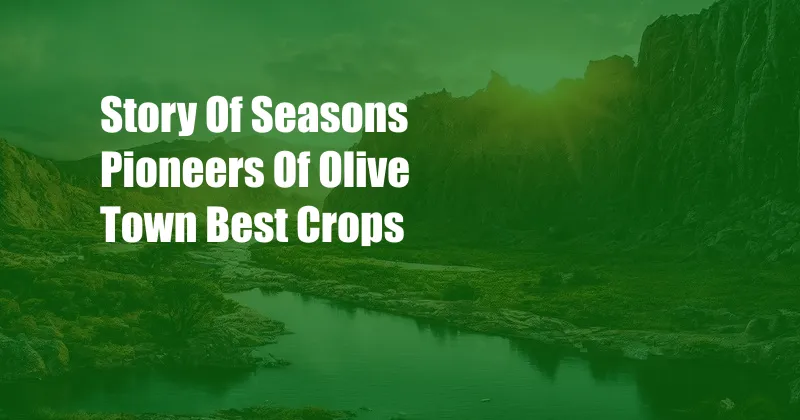
The Story of Seasons: Pioneers of Olive Town – Your Guide to the Best Crops
The Story of Seasons: Pioneers of Olive Town is the latest installment in the beloved farming simulation series. In this charming game, you’ll inherit your grandfather’s old farm and embark on a journey to revitalize it. One of the most important aspects of the game is growing crops, as they are the primary source of income and resources.
With a wide variety of crops to choose from, it can be overwhelming to know which ones are the best to grow. In this blog post, we will provide you with a comprehensive guide to the best crops in Story of Seasons: Pioneers of Olive Town, helping you maximize your profits and progress.
Choosing the Right Crops
The best crops to grow in Story of Seasons: Pioneers of Olive Town depend on several factors, including the season, your available resources, and your personal preferences. However, some general tips to keep in mind include:
- Consider the seasonality of crops. Some crops can only be grown during specific seasons, so plan your planting accordingly.
- Choose crops that are high-value. The more valuable a crop is, the more money you’ll make from selling it.
- Select crops that are easy to grow. If you’re new to the game, start with crops that are low-maintenance and don’t require a lot of care.
Top 5 Most Profitable Crops
Based on the criteria above, here are the top 5 most profitable crops to grow in Story of Seasons: Pioneers of Olive Town:
- Strawberries: Strawberries are a high-value crop that can be grown in the spring and fall. They are relatively easy to grow and require minimal care.
- Blueberries: Blueberries are another high-value crop that can be grown in the summer and fall. They are slightly more difficult to grow than strawberries, but they are still a good option for beginners.
- Melons: Melons are a high-value crop that can be grown in the summer. They are a bit more challenging to grow than strawberries and blueberries, but they can be very profitable.
- Pineapples: Pineapples are a high-value crop that can be grown in the summer and fall. They are the most difficult crop to grow on this list, but they are also the most profitable.
- Grapes: Grapes are a high-value crop that can be grown in the fall. They are relatively easy to grow and require minimal care.
Tips for Growing the Best Crops
In addition to choosing the right crops, there are a few other tips you can follow to maximize your profits and grow the best crops possible:
- Fertilize your crops regularly. Fertilizing helps to increase the yield and quality of your crops.
- Water your crops regularly. Watering your crops is essential for their growth, but be careful not to overwater them.
- Protect your crops from pests. Pests can damage your crops, so it’s important to take steps to protect them.
- Harvest your crops at the right time. Harvesting your crops at the right time will maximize their value.
FAQs about Crops in Story of Seasons: Pioneers of Olive Town
Here are some frequently asked questions about crops in Story of Seasons: Pioneers of Olive Town:
- Q: What is the best way to fertilize my crops?
- A: The best way to fertilize your crops is to use high-quality fertilizer. You can purchase fertilizer from the General Store or make your own using the Composter.
- Q: How often should I water my crops?
- A: You should water your crops every day, but be careful not to overwater them. Overwatering can damage your crops.
- Q: How can I protect my crops from pests?
- A: You can protect your crops from pests by using insecticides or by building fences around your farm.
- Q: When is the best time to harvest my crops?
- A: The best time to harvest your crops is when they are fully mature. You can check the maturity of your crops by examining them in your inventory.
Conclusion
Growing crops is an essential part of Story of Seasons: Pioneers of Olive Town. By following the tips and advice in this guide, you’ll be able to grow the best crops possible and maximize your profits. So what are you waiting for? Start farming today and experience the joy of growing your own food!
We hope you found this guide helpful. If you have any questions or comments, please feel free to leave them below. We’d love to hear from you!